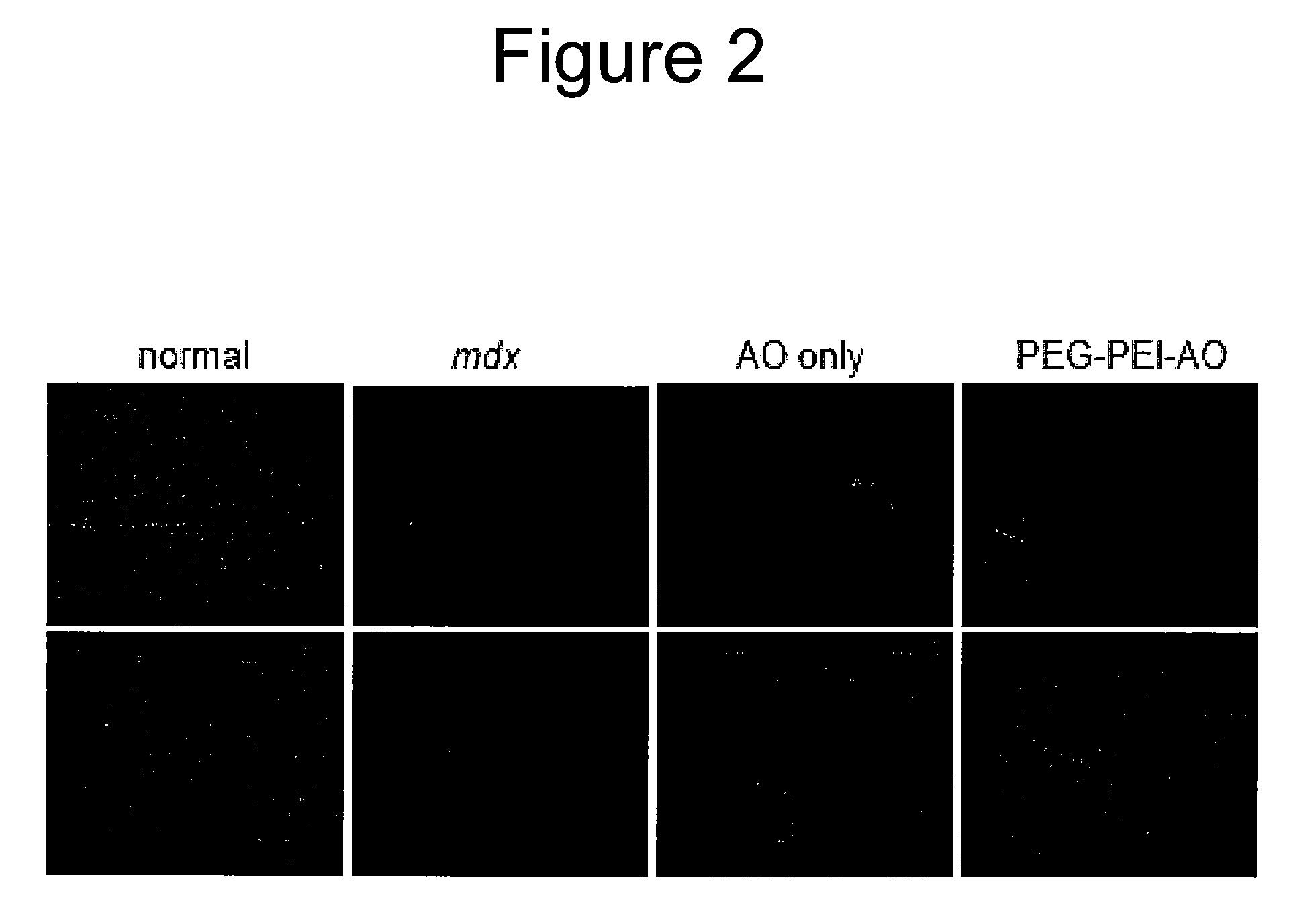Improved carriers for delivery of nucleic acid agents to cells and tissues
a nucleic acid agent and carrier technology, applied in the field of drug delivery, can solve the problems of cytotoxicity and serum reactivity, the inability to effectively deliver small nucleic acid agents to target cells, etc., to achieve the effect of improving the delivery of nucleic acid agents, broad applicability and improved functionality
- Summary
- Abstract
- Description
- Claims
- Application Information
AI Technical Summary
Benefits of technology
Problems solved by technology
Method used
Image
Examples
example 1
Polyplex Stability Measured by Polyanion Competition Assay
[0203]In a useful polyplex delivery system, the electrostatic charge association between the NAA and copolymer must be strong enough to promote cellular uptake, but not too strong as to prohibit release so that NAA can be translocated to target cell nuclei. A polyanion competition assay can assess the relative stability, or association-dissociation dynamics, of the various polyplexes (FIG. 1d; see also FIGS. 5 & 6 in (Glodde, M et. al. (2006) Biomacromolecules. V7(1). 347-356)). Heparin, a linear polysaccharide bearing sulfonate groups, can be used as a model polyanion. Polyplexes are incubated with varying amounts of heparin, electrophoresed on agarose gels, and the intensity of the “free NAA” band (i.e., released NAA) was quantified. Surprisingly, we found PEI2K-based polyplexes to be substantially more stable than several of the PEI25K-based polyplexes. The most stable polyplex, PEI2K(PEG5K)10-NAA, had an IC50 value about ...
example 2
Induction of Dystrophin Expression in Skeletal Muscles of mdx Mice Following Intramuscular Injections of PEG-PEI-AO Polyplexes
[0204]PEG-PEI-AO Induction of Dystrophin Expression at 3 Weeks Post-Transfection
[0205]We measured AO-mediated dystrophin expression in mdx mice at 3 weeks after intramuscular injection of AO complexed with low and high MW PEG-PEI copolymers (Williams, J H et. al. (2006) Mol. Ther. V14(1). 88-96). For these studies we used the 6-FAM-2′O-methyl antisense oligoribonucleotide (2OMeAO) that has previously been shown to induce skipping of exon 23 in mdx mice (Lu, Q L et. al. (2003) Nat. Med. V9. 1009-1014.; Lu, Q L et. al. (2005) Proc. Natl. Acad. Sci. U.S.A V102. 198-203), the site of a point mutation encoding an early termination signal. In this study, mdx mice (8 wks of age) were anesthetized and TA muscles were injected with 20 μg of AO, complexed with the following copolymers: PEI2K(PEG550)10, PEI25K(PEG5K)25, and PEI25K(PEG5K)50. To facilitate comparison with...
example 3
GNP Conjugation to Low MW PEI2K-Based Copolymers Improves Transfection Capacity and Dystrophin Induction by PEG-PEI-Oligonucleotide Polyplexes
[0211]GNPs have previously been shown to improve cellular uptake and biocompatibility of polymeric nucleotide carriers (Hainfeld, J F et. al. (2000) J. Histochem. Cytochem. V48. 471-480.; Thomas, M et. al. (2003) Proc. Natl. Acad. Sci. U.S.A V100. 9138-9143.) and internalization of gold nanoparticles into various cell types including muscle cells has been demonstrated (Kaisto, T et. al. (1999) Exp. Cell Res. V253.551-560.; Shukla, R et. al. (2005) Langmuir V21. 10644-10654.; Thomas, M et. al. (2003) Proc. Natl. Acad. Sci. U.S.A V100. 9138-9143). Therefore, we examined the influence of conjugating GNP to low MW PEI2K(PEG550)10 copolymers. Western analysis of muscles 3 wks after transfection with GNP-PEI2K(PEG550)10-AO (FIG. 5, lanes 7-8) showed substantially higher levels of dystrophin expression (mean=15.1%; peak value=20.1%; N=2) than our pre...
PUM
| Property | Measurement | Unit |
|---|---|---|
| MW | aaaaa | aaaaa |
| MW | aaaaa | aaaaa |
| molar ratio | aaaaa | aaaaa |
Abstract
Description
Claims
Application Information
 Login to View More
Login to View More - R&D
- Intellectual Property
- Life Sciences
- Materials
- Tech Scout
- Unparalleled Data Quality
- Higher Quality Content
- 60% Fewer Hallucinations
Browse by: Latest US Patents, China's latest patents, Technical Efficacy Thesaurus, Application Domain, Technology Topic, Popular Technical Reports.
© 2025 PatSnap. All rights reserved.Legal|Privacy policy|Modern Slavery Act Transparency Statement|Sitemap|About US| Contact US: help@patsnap.com



